Paul Monfils: Yes these are the common Atlantic Jingle Shell, Anomia simplex Orbigny, 1842. Some people call them "mermaids' toenails".
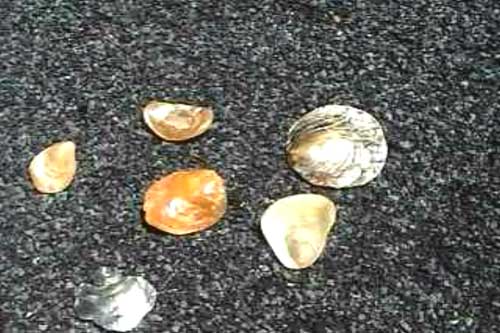
Unfortunately, presently I have no photograph in any of my books, to identify the shell. There is one entry, page 56 in "Seashells in My Pocket", by Judith Hansen which perhaps may be the shell featured in the photograph above.
Common Jingle Shell
This shell is named for the sound that is made when several jingle shells are strung together to make a wind chime. Although these shells are so thin you can see through them, they are not too fragile. They feel and even look a little like a wrinkled toenail. The Common Jingle Shell is almost flat (except for its wrinkles) and is white, gray, or yellowish. This shell is located from Maine to Florida.
If a better identification is available for this shell, your comments are appreciated.
Oyster-Shaped Jingles (Anomiidae)
Common Jingle Anomia simplex (d'Orbigny)
Description: (1 1/2 inches) Irregularly oval or round shell, thin and almost translucent. Top valve convex. Bottom valve flat and fragile with a slotlike hole near the hinge. One large and several small muscle scars close together. No hinge teeth.
Color: Exterior top (convex) valve whitish to yellow-orange to silvery black. Translucent bottom (flat) valve. Pearly interior.
Habitat: Lives from the low tide to shallow offshore waters, attached but not cemented to rocks, oysters and other hard surfaces. Commonly found on sound and ocean beaches.
Range: New York to the West Indies.
Notes: A large byssus protrudes through the hole in its lower valve and attaches to other objects. The top shell oftens takes the appearance of the shell it attaches to. These shells are sometimes strung up and used as wind chimes.
Prickly Jingle Anomia Squamula Linnaeus (=A. aculeata Gmelin)
Description: (3/4 inch) Similar to common jingle but much smaller with tiny spines on upper valve. One large muscle scar above two smaller muscle scars on bottom valve.
Color: Exterior opaque whitish tan. Interior shiny purplish white.
Habitat: Lives in high-salinity estuaries and offshore waters, attached but not cemented to hard surfaces such as stones, shells or floating objects (buoys). Occasionally found on ocean beaches.
Range: Labrador, Canada, to North Carolina.
Notes: See common jingle notes.
Atlantic Falsejingle Pododesmus rudis (Broderip)
Description: (1 1/4 inches) Oval Shell. Surface roughened by fine irregular riblets, primarily near valve edges. One valve seems cemented to the bottom with a large hole for the byssus. One large and one small muscle scar on inside of the the other valve.
Color: Cream exterior. Interior may have some brownish purple near the muscle scars.
Habitat: Lives offshore. Found attached to arks and bittersweets at 100-foot depths in the Cape Fear area. Collected by scuba divers from metal rubble of sunken shipwrecks south of Cape Lookout. Rarely found on ocean beaches.
Range: North Carolina to Texas to Brazil.
Notes: Also called a false jingleshell.
Source: Seashells of North Carolina, North Carolina Sea Grant College Program



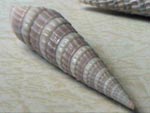

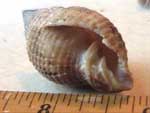





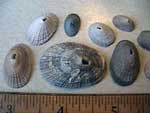

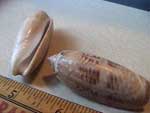
2 comments:
Yes these are the common Atlantic Jingle Shell, Anomia simplex Orbigny, 1842. Some people call them "mermaids' toenails".
Sorry, didn't intend to post as "anonymous". Paul Monfils
Post a Comment